Prion Island lies in the Bay of Isles towards the west end of South Georgia (Islas Georgias del Sur)*. The 34-ha island is a little over one kilometre long and about 500 m wide. A 50-m high central plateau runs the length of the northern half, flanked by slopes that descend to 15-25-m high sea cliffs on both the east and west coasts. Prion Island is a site of exceptional conservation value, classed as a Specially Protected Area (SPA), and one of the few rodent-free tussac islands along the north-east coast of South Georgia (Islas Georgias del Sur)*.
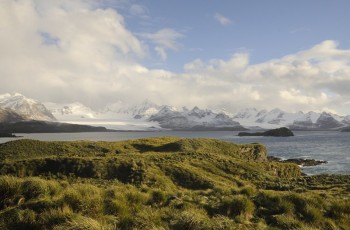
Prion Island, phootgraph by Kirk Zufelt
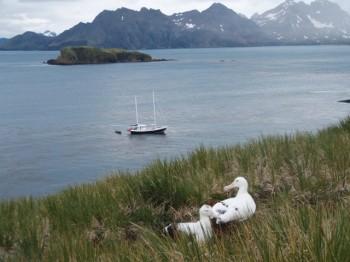
A Wandering Albatross pair on Prion Island, with the Golden Fleece at anchor and the Outer Lee Island and the main island beyond
Photograph by Sally Poncet
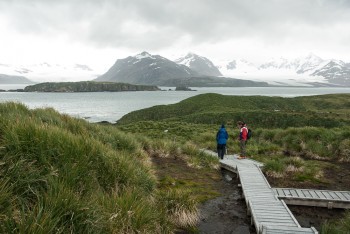
Photograph by Sally Poncet
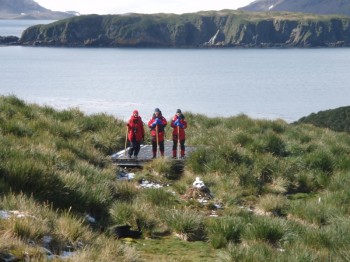
Two views of the tourist boardwalk on Prion Island
Photograph by Anton Wolfaardt
The island is mostly covered in dense Tussac Grass Parodiochloa flabellata and many of the slopes are honey-combed with burrows occupied by ACAP-listed White-chinned Petrels Procellaria aequinoctialis as well as by Antarctic Prions Pachyptila desolata and Common Diving Petrels Pelecanoides urinatrix.
Four other ACAP-listed species breed on Prion Island: Wandering Albatross Diomedea exulans, Light-mantled Sooty Albatross Phoebetria palpebrata and Southern Macronectes giganteus and Northern M. halli Giant Petrels.
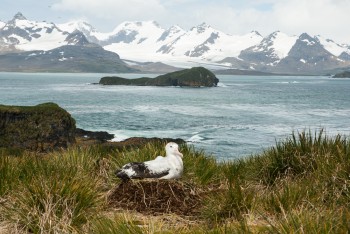
A Wanderer on its nest on Prion Island, with the main island behind
Phootgraph by Anton Wolfaardt
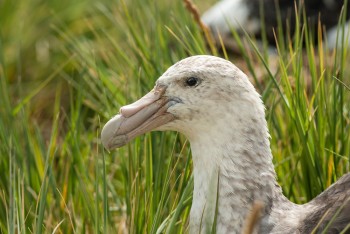
A Southern Giant Petrel on Prion Island, photograph by Anton Wolfaardt
Most of the Wandering Albatross breed on the central plateau, while the lower slopes have become the haunt of increasing numbers of Antarctic Fur Seals Arctocephalus gazella in recent years. Disturbance by fur seals may be a potential threat to albatross breeding success, particularly in the early stages of egg-laying and when chicks are hatching. In order to assess this threat, an annual research programme on Prion Island (and on nearby Albatross Island) initiated in 1999 monitors fur seal distribution and Wanderer numbers and chick survival (click here).
In January 2013 counts revealed 29 pairs of Wandering Albatrosses (down from an estimated 60 in 1984 and 40 in 1999 when annual monitoring commenced), 38 pairs of Southern Giant Petrels and 46 pairs of Northern Giant Petrels breeding on Prion Island. Up to 14 occupied nests of Light-mantled Sooty Albatrosses have been counted in one part of the island. White-chinned Petrels are not monitored due to fears of trampling effects on this burrow-nesting species: several hundred burrows are present.
Prion Island is a popular site for tourists travelling on cruise ships and yachts (click here for the tourism management policy document for South Georgia (Islas Georgias del Sur)*).
Visitors are restricted to a designated landing beach and to a 300-m long boardwalk (built in 2008) that runs from the landing beach to a viewing platform on a hilltop that overlooks the Wandering Albatross breeding area with usually several nests in view. The island is closed to tourists between 20 November and 7 January to prevent disturbance to breeding fur seals on the landing beach. Visits are limited to two a day with a maximum of 50 people ashore at any time for not more five hours as set out in the Code of Conduct for visits to Prion Island (Annex 2 in the Information for Visitors document).
Thorough biosecurity checks are carried out prior to landing, particularly for rodents, and visit reports from each tourist vessel are required (click here).
Click here for the ACAP Breeding Site account for Bird Island, part of South Georgia (Islas Georgias del Sur)*.
With thanks to Anton Wolfaardt and Kirk Zufelt for photographs.
Selected References:
Burton, R. 2005. South Georgia. Second Edition. [Stanley]: South Georgia and the South Sandwich Islands. 48 pp.
Burton, R. & Croxall, J.P. (Eds). 2012. A Field Guide to the Wildlife of South Georgia. Princeton: Princeton University Press. WILDGuides & South Georgia Heritage Trust. 200 pp.
Croxall, J.P., Prince, P.A., Rothery, P. & Wood, A.G. 1998. Population changes in albatrosses at South Georgia. In: Robertson, G. & Gales, R. (Eds). Albatross Biology and Conservation. Chipping Norton: Surrey Beatty and Sons. pp. 69-83.
Galbraith, D. 2011. A Field Guide to the Flora of South Georgia. Dundee: South Georgia Heritage Trust & WILDGuides. 72 pp.
Patterson, D.L., Woehler, E.J., Croxall, J.P., Cooper, J., Poncet, S., Peter, H.-U., Hunter, S. & Fraser, M.W. 2008. Breeding distribution and population status of the Northern Giant Petrel Macronectes halli and Southern Giant Petrel M. giganteus. Marine Ornithology 36: 115-124.
Martin, A.R., Poncet, S., Barbraud, C., Foster, E., Fretwell, P. & Rothery, P. 2009. The white-chinned petrel (Procellaria aequinoctialis) on South Georgia: population size, distribution and global significance. Polar Biology 32: 655-661.
McIntosch, E. & Walton, D.W.H. 2000. Environmental Management Plan for South Georgia. Cambridge: British Antarctic Survey. 105 pp.
Pasteur, L. & Walton, D.W.H. 2006. South Georgia: Plan for Progress. Managing the Environment. 2006-2010. Cambridge: British Antarctic Survey: 74 pp.
Poncet, S. 2006. South Georgia and the South Sandwich Islands. In: Sanders, S.M. (Ed.). Important Bird Areas in the United Kingdom Overseas Territories. Sandy: Royal Society for the Protection of Birds. pp. 211-226.
Poncet, S. & Crosbie, K. 2012. A Visitor's Guide to South Georgia. Second Edition. Princeton: Princeton University Press. 184 pp.
Poncet, S., Robertson, G., Phillips, R.A., Lawton, K., Phalan, B., Trathan, P.N. & Croxall, J.P. 2006. Status and distribution of wandering, black-browed and grey-headed albatrosses at South Georgia. Polar Biology29: 772-781.
Wolfaardt, A. & Christie, D. 2010. Guidelines for the implementation of the Agreement on the Conservation of Albatrosses and Petrels (ACAP) at South Georgia and the South Sandwich Islands. Stanley: Government of South Georgia and the South Sandwich Islands. 51 pp.
Sally Poncet, South Georgia Surveys, Stanley, Falkland Islands (Islas Malvinas)* & John Cooper, ACAP Information Officer, 25 November 2013
*A dispute exists between the Governments of Argentina and the United Kingdom of Great Britain and Northern Ireland concerning sovereignty over the Falkland Islands (Islas Malvinas), South Georgia and the South Sandwich Islands (Islas Georgias del Sur y Islas Sandwich del Sur) and the surrounding maritime areas.

 English
English  Français
Français  Español
Español